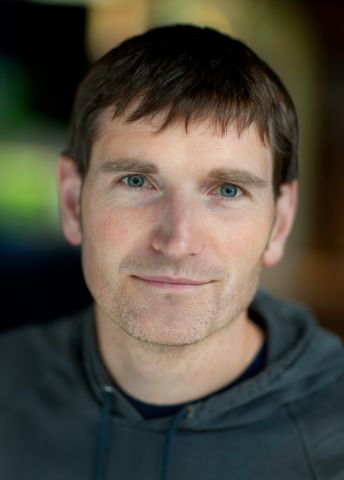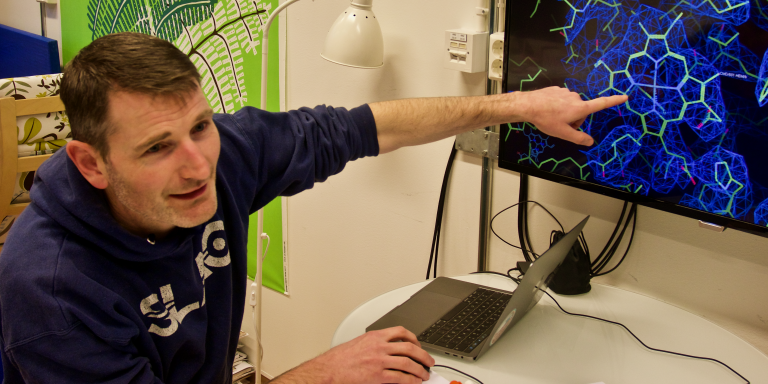
Martin Högbom
Professor of Structural Biochemistry
Wallenberg Scholar
Institution:
Stockholm University
Research field:
Structural biochemistry and bioinorganic chemistry


Wallenberg Scholar
Institution:
Stockholm University
Research field:
Structural biochemistry and bioinorganic chemistry
Occupying center stage are proteins that can convert methane into methanol and an enzyme called ribonucleotide reductase (RNR), which synthesizes the building blocks of DNA.
“As with my Wallenberg Academy Fellow grant, I’m researching fundamental questions. You might say that this is the Fellow grant on steroids,” Högbom says, laughing.
The question “how does it work?” is the central driver for this project. Work on developing potential applications will fall to others.
Whereas Högbom’s earlier research concentrated on how a protein can choose the “right” metal in the cell to achieve a desired reaction, and tune the reactivity to create the right chemical conditions, his aim in the present project is to understand the chemical processes involved.
“The elegance lies in the fact that the metal itself cannot trigger chemical reactions in the way the protein does. The protein binds the metal to itself and changes the environment of the metal ion. This enables the protein to control reactivity and cause all kinds of chemical reactions to occur.”
Although Högbom considers that the earlier research has enabled his team to gain a better understanding, much remains to be done. And even though they are carrying out basic research, there are applications on the horizon. One example he likes to give concerns offshore oil rigs. Drilling for oil releases methane, which is burnt off in a gas flare on the platform. Methane gas exacerbates the greenhouse effect.
“It is estimated that the oil industry burns off thirty billion dollars’ worth of methane every year because doing so is still cheaper than collecting, storing and transporting it. This is crazy, both in economic and in environmental terms. But if the methane could be converted into methanol, it could be transported in tankers, for example, and be used in various ways.”
At present this is not done; the industrial processes are simply too costly and inefficient. But the researchers know there are bacteria with enzymes that perform this reaction.
“We’re studying a protein that uses iron to convert methane into methanol. We are interested in understanding how it does it. If we can work it out, then it might be possible to mimic that reaction and scale it up into an industrial process.”
It is fairly common for proteins to make use of metals. It is estimated that one-third of them do so.
“We’re studying a handful of enzymes that perform difficult and important reactions.”
One of them is RNR. It synthesizes the building blocks of DNA, and is thus essential to all organisms. RNR is already used as a cancer therapeutic target. Most healthy cells in an adult body rarely need to copy DNA, whereas cancer cells have to create a new copy of their genome every time they divide. Drugs that target RNR can therefore halt cancer growth without too much impact on the rest of the body.
The process is somewhat similar in bacterial infections, where the bacteria multiply rapidly by division.
“If we can stop division, we can prevent infection from spreading. We have discovered a couple of variants in the way this enzyme works in bacteria that differ from the way it works in humans. This offers a pathway to disrupting bacterial DNA synthesis but not our own. We have discovered, for instance, that mycoplasma use a different mechanism than the one used in humans.”
Mycoplasma is a bacterium that infects the mucosa, causing a form of pneumonia and certain STDs. Högbom and his colleagues have identified a central part of the system that synthesizes DNA building blocks that is completely different.
“Most of all, we want to understand the process. But of course we would be delighted if someone follows on and develops a drug or, as in the other case, a catalyst for methane gas conversion.”
“The grant is a huge acknowledgement, and also gives me the confidence to conduct really difficult research. It has meant a great deal. It enables us to think ‘this is really difficult, but we’ll give it a go’.”
The development of new technologies and methods has enabled the researchers to study these processes. The advent of X-ray free electron laser facilities means they can start reactions in a crystal, expose it to X-rays, and examine the structure at different time intervals.
“We can see how the reaction occurs in the protein, and how the protein manages to control the process.”
Högbom’s team is collaborating with research teams at Stanford, Berkeley and the University of Minnesota.
“We’re working with the best in the world, which is a must. Performing the experiments amounts to a research project in itself. For thirty years scientists have been saying that we will soon know how these processes work, but those predictions have been confounded – a central piece of the puzzle has been missing. It is that piece that we are now trying to put in place.”
Högbom says that he has always been interested in science, with a desire to understand why things are as they are, and how they work.
“When I was young I took our vacuum cleaner to pieces to find out how it worked. I think I chose chemistry because it seemed to be the broadest subject. When I studied biochemistry, I became fascinated by enzymes, which can perform chemistry in ways that we cannot. How is it that nature can do these reactions? How has biology managed to tame chemistry? It’s tantalizing that nature seems to find these things so easy.”
Text Carina Dahlberg
Translation Maxwell Arding
Photo Dan Sjöstrand, Magnus Bergström